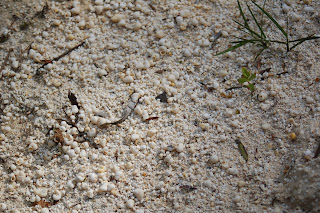These cave fills are often the best source of fossils for terrestrial ecosystems since the caves create sink holes in the middle of the forest and animals who wouldn’t normally get deposited in a lake (rodents, monkeys, lizards etc.) get swept into the cave. One cave-fill contained rocks that were almost entirely composted of bones and teeth that were cemented together by the calcite that had seeped out of the cave walls (the same calcite that grows into beautiful cave forations):

Another cave was a chimney-like shaft where we sifted through sand for Oligocene teeth and bones. It’s always gratifying to collect where you actually find vertebrate bone (assuming you’re a vertebrate paleontologist). That site was especially exciting because it required some careful scrambling through briars and over outcropped rock. A cliff face and rock ledge will always make a geological expedition more fun.

We also examined a cave that hasn’t been filled in yet. It formed underground like a rocky bubble and lay unexposed for millennia until the surrounding rock finally winnowed away leaving a chamber just big enough for a family and the kids. And that’s exactly what it was used for. Cro-Magnon people (early modern humans) rolled into the area and liked the view overlooking the entire basin. It was probably a good spot to watch for mammoths, and even better for watching the sunset.

We ate lunch on the crest of a hill near the Cro-Magnon cave. Boulders protruded from the field of lush grass and wildflowers creating a gorgeous landscape in want of a henge or barrow. I dangled my feet over the edge of a boulder.

To my left was another hill and another outcrop where excavators had found a butchered wooly rhino skeleton from the Paleolithic (50,000 years ago), and a small encampment from the Neolithic (10,000 years ago). Mesozoic rocks, Oligocene fossils, human artifacts…this is Germany. This is why I came here.

We also stopped by a 15 million year old impact crater. When large rocks smack into the earth, the bedrock ripples like the surface of a pond, mixing up the layers and leaving an uplifted central platform; the earth’s frozen rebound to the power of the asteroid. The crater quickly filled with water and became a popular place to stop for a drink when horses were still sporting three toes.
The town of Steinheimer is nestled into the bowel now, sitting on top of a thick sequence of lake sediment. An observant Steinheimer scientist named Hilgendorf started to pay attention to the snail shells that were preserved under his feet. As he burrowed deeper, he noticed the shells were more standardized, more basic. By collecting shells from the beginning of the lake to the end, he demonstrated how one colonizing species gave rise to new species of snails through intermediary steps. He published his work in 1862 and is credited as being the first scientist to demonstrate Mr. Darwin’s crazy new theory of change through time and the emergence of speices. I collected some of those snails out of historical respect more than out of a need to add more mollusks to my luggage.
 The classic branching of speciees outlined by Hilgendorf a few years after Mr. Darwin published his bright idea.
The classic branching of speciees outlined by Hilgendorf a few years after Mr. Darwin published his bright idea.
At a traditional inn next to the castle, we toasted the final night of the expedition with delicious Heles beer and happily stumbled home.
 On the distant horizon you can see the Swiss Alps rearing their beautiful heads. I'm standing on a crater rim by the by.
On the distant horizon you can see the Swiss Alps rearing their beautiful heads. I'm standing on a crater rim by the by. A toe quiz. I rocked this one. Do you know which critters are on display here? Hint, they have hooves and are distantly related to each other by having odd numbers of toes.
A toe quiz. I rocked this one. Do you know which critters are on display here? Hint, they have hooves and are distantly related to each other by having odd numbers of toes.After returning from the field I diligently worked on my fossils, attended a lecture on Creationism given by an angry Australian Geologist (more on that next week after I give my own talk on the history of American Creationism), and went to visit Marco for Japan Tag (Japan Day), a celebration of Düsseldorf’s Japanese population with heaps of street sushi, noodles, and Kirin Beer. The streets were packed with Germans demonstrating karate and dressed as their favorite Anime character in a mini-skirt. The night was rounded off with the largest fireworks display in Düsseldorf, which was vaguely disappointing after years spent at Riverfest and the Blue Ash Fireworks displays. Germany may have cavemen, but it doesn’t make things explode into brilliant colors quite like we do at home.
I hope you had a fantastic weekend and are mentally prepared for the coming week. I’m just getting back into town after a tour of Switzerland, the Rhineland, the Low Countries, and England with friends from Ohio State. Stay tuned for adventures such as cycling in Amsterdam, climbing in the Alps, and theater gooning in the West End!




No comments:
Post a Comment